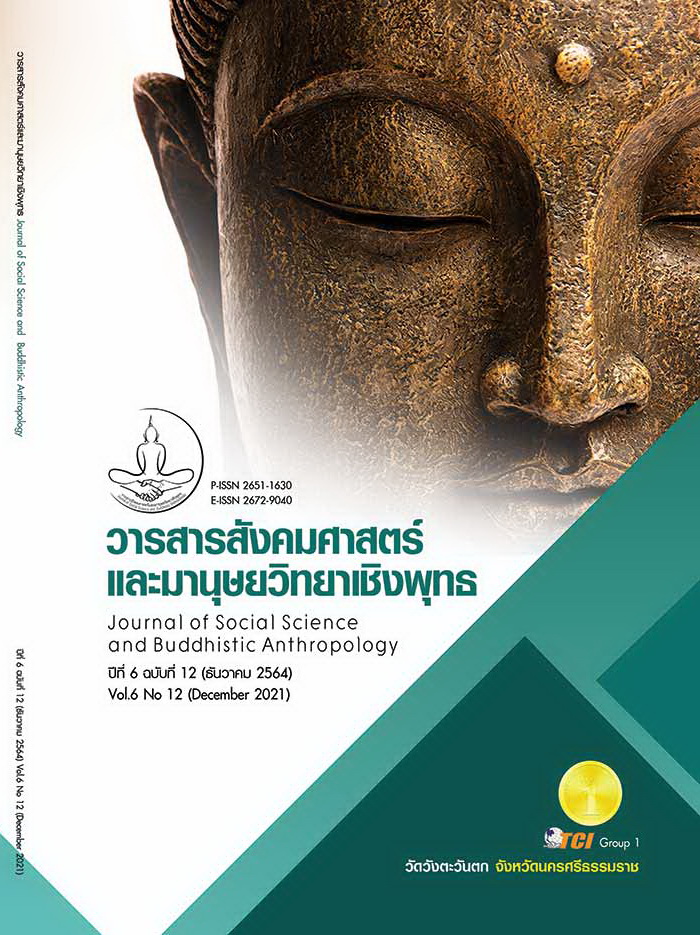DEVELOPMENT OF THE CONTEMPORARY THAI WICKER HANDICRAFTS OF THE HANDICRAFT COMMUNITY ENTERPRISE TOWARDS SUSTAINABILITY. A MULTI-SITE CASE STUDY
Keywords:
The Development of Contemporary Thai Basketry Arts and Crafts, Community Enterprises, Sustainability, Multisite StudyAbstract
The objectives of this research article were to study the present conditions and problems in the development of contemporary arts and crafts in community enterprises and study the process of developing contemporary Thai arts and crafts in community enterprises that can lead towards sustainability. This research was the qualitative methodology by studying the Toei Panan Ban Duhun community enterprise products, and the Krajood Wannee handicraft community enterprise. The study used a specific sample selection process and applied a snowball procedure. Data were consolidated by structured interviews from experts in related fields and a sample group of 12 persons, by analyzing documents and observation forms. Results shows that under the current conditions, community enterprises are producing handicrafts from local raw materials that have sentimental and intellectual value with their religion as the center of local activities. They cohabit as kinship and are receptive to outside culture. They have strong community leaders who adhere firmly to the sufficiency economy concept, who maintain balance to the raw material ecosystem and preserve traditional wisdom. Problems are encountered due to the reduced popularity of original weaving patterns, their youth unwillingness in learning on how to weave, the unpopularity on the use of basketry, unbalanced community enterprise production, and the use of chemicals in the production process. The process of developing contemporary Thai arts and crafts weaving of the community enterprises’ handicraft towards sustainability, consist of; developing an understanding of being a handicraft community enterprise, further development of the local arts and culture, transferring the wisdom of producing handicrafts, and knowing on how to adapt and receive support from the government. The above results have led towards recommendations for the development of other arts and crafts community enterprises which can be applied to create product values that can be further developed into a creative economy concept.
References
กรมส่งเสริมการเกษตร. (2548). วิสาหกิจชุมชน (Community Enterprise). เรียกใช้เมื่อ 4 ธันวาคม 2563 จาก http://www.sceb.doae.go.th/law.htm
กฤษณ์ จารุดํารงค์ศักดิ์. (2560). การประเมินความยั่งยืนของวิสาหกิจชุมชน: กรณีศึกษาวิสาหกิจชุมชนกลุ่มแม่บ้าน เกษตรกรบ้านแลงพัฒนา. ใน วิทยานิพนธ์วิทยาศาสตรมหาบัณฑิต สาขาการจัดการสิ่งแวดล้อม. สถาบันพัฒนบริหารศาสตร์.
จรัสพิมพ์ วังเย็น. (2554). แนวคิดหลังสมัยใหม่: การย้อนสู่โลกแห่งภูมิปัญญา. วารสารสถาบันวัฒนธรรมและศิลปะ, 13(1), 20-23.
จามร พงษ์ไพบูลย์. (2550). กระบวนการเรียนรู้และสืบทอดภูมิปัญญาท้องถิ่น: กรณีศึกษา "เพลงโหงฟาง" ของจังหวัดตราด. ใน วิทยานิพนธ์ศิลปศาสตรมหาบัณฑิต สาขาพัฒนศึกษา. มหาวิทยาลัยบูรพา.
ชยาพร วัฒนศิริ และคณะ. (2553). รายงานการวิจัย การพัฒนาเกษตรอินทรีย์แบบวิถีชุมชน. กรุงเทพมหานคร: มหาวิทยาลัยสุโขทัยธรรมาธิราช.
ณัฐวดี พัฒนโพธิ์. (2560). การพัฒนาศักยภาพกลุ่มแปรรูปผลิตภัณฑ์จากต้นกก บ้านโนนนาค ตำบลบัวบาน อำเภอยางตลาด จังหวัดกาฬสินธุ์. วารสารการบริหารปกครอง มหาวิทยาลัยกาฬสินธุ์, 6(ฉบับพิเศษ), 120-132.
ตระกูลพันธ์ พัชรเมธา. (2559). ผลิตภัณฑ์หัตถกรรมกับการพัฒนาสู่สินค้าหนึ่งตำบลหนึ่งผลิตภัณฑ์. วารสารมหาวิทยาลัยศิลปากร ฉบับภาษาไทย สาขาสังคมศาสตร์ มนุษยศาสตร์ และศิลปะ, 36(1), 67-80.
เทพพร มังธานี. (2563). ศิลปะทางศาสนาแนวคิดพื้นฐานและแนวทางการศึกษา. วารสารศาสนาและปรัชญา, 5(1), 19-33.
ภิศักดิ์ กัลยาณมิตร. (2558). การพัฒนาทุนทางสังคมสู่การพัฒนาที่ยั่งยืนตามปรัชญาเศรษฐกิจพอเพียง. วารสารวิจัยและพัฒนา วไลยองค์กรณ์ในพระบรมราชูปถัมภ์ สาขามนุษยศาสตร์และสังคมศาสตร์, 11(3), 305-317.
ระพีพรรณ มูหะหมัด. (2556). อิสลามกับการพัฒนาอย่างยั่งยืน : กรณีศึกษาชุมชนมัสยิดกมาลุล อิสลาม คลองแสนแสบ กรุงเทพมหานคร. ใน วิทยานิพนธ์วิทยาศาสตรมหาบัณฑิต สาขาการจัดการสิ่งแวดล้อม. สถาบันบัณฑิตพัฒนบริหารศาสตร์.
วิจารณ์ พานิช. (2556). สนุกกับการเรียนในศตวรรษที่ 21. กรุงเทพมหานคร: มูลนิธิสดศรี-สฤษดิ์วงศ์.
วิบูล ลี้สุวรรณ. (2558). พจนานุกรมหัตถกรรมเครื่องมือเครื่องใช้พื้นบ้าน. กรุงเทพมหานคร: เมืองโบราณ.
โศรยา หอมชื่น. (2554). เศรษฐกิจสร้างสรรค์. จุลสารวิชาการท่องเที่ยวอิเล็กทรอนิกส์. เรียกใช้เมื่อ 4 ธันวาคม 2563 จาก https://www.sacict.or.th/th/detail/2020-10-02-19-12-37
สำนักงานคณะกรรมการพัฒนาการเศรษฐกิจ และสังคมแห่งชาติ. (2560). แผนพัฒนาเศรษฐกิจและสังคมแห่งชาติ ฉบับที่สิบสอง พ.ศ. 2560- 2564. เรียกใช้เมื่อ 18 ตุลาคม 2563 จาก http://www.nesdb.go.th/ewt_dl_link.php?nid=6422
เสรี พงศ์พิศ. (2550). วิสาหกิจชุมชน กลไกเศรษฐกิจฐานราก. กรุงเทพมหานคร: เอดิสันเพรส โปรดักส์.
Thom, M. (2016). Crucial Skills for the Entrepreneurial Success of Fine Artists. Artivate, 5(1), 3-24.
Uphoff, N. (1996). Learning from Gal Oya - Possibilities for Participatory Development and Post-Newtonian Social Science. Retrieved October 18, 2020, from https://journals.sagepub.com/doi/abs/10.1177/101852911 9960206
Downloads
Published
How to Cite
Issue
Section
License
Copyright (c) 2021 Journal of Social Science and Buddhistic Anthropology

This work is licensed under a Creative Commons Attribution-NonCommercial-NoDerivatives 4.0 International License.








